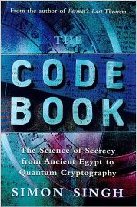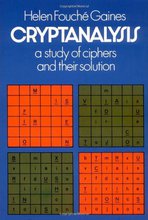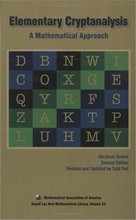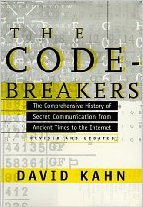Autokey Cipher
Introduction §
The Autokey Cipher is a polyalphabetic substitution cipher. It is closely related to the Vigenere cipher, but uses a different method of generating the key. It was invented by Blaise de Vigenère in 1586, and is in general more secure than the Vigenere cipher.
The Algorithm §
The 'key' for the Autokey cipher is a key word. e.g. 'FORTIFICATION'
The Autokey cipher uses the following tableau (the 'tabula recta') to encipher the plaintext:
A B C D E F G H I J K L M N O P Q R S T U V W X Y Z
---------------------------------------------------
A A B C D E F G H I J K L M N O P Q R S T U V W X Y Z
B B C D E F G H I J K L M N O P Q R S T U V W X Y Z A
C C D E F G H I J K L M N O P Q R S T U V W X Y Z A B
D D E F G H I J K L M N O P Q R S T U V W X Y Z A B C
E E F G H I J K L M N O P Q R S T U V W X Y Z A B C D
F F G H I J K L M N O P Q R S T U V W X Y Z A B C D E
G G H I J K L M N O P Q R S T U V W X Y Z A B C D E F
H H I J K L M N O P Q R S T U V W X Y Z A B C D E F G
I I J K L M N O P Q R S T U V W X Y Z A B C D E F G H
J J K L M N O P Q R S T U V W X Y Z A B C D E F G H I
K K L M N O P Q R S T U V W X Y Z A B C D E F G H I J
L L M N O P Q R S T U V W X Y Z A B C D E F G H I J K
M M N O P Q R S T U V W X Y Z A B C D E F G H I J K L
N N O P Q R S T U V W X Y Z A B C D E F G H I J K L M
O O P Q R S T U V W X Y Z A B C D E F G H I J K L M N
P P Q R S T U V W X Y Z A B C D E F G H I J K L M N O
Q Q R S T U V W X Y Z A B C D E F G H I J K L M N O P
R R S T U V W X Y Z A B C D E F G H I J K L M N O P Q
S S T U V W X Y Z A B C D E F G H I J K L M N O P Q R
T T U V W X Y Z A B C D E F G H I J K L M N O P Q R S
U U V W X Y Z A B C D E F G H I J K L M N O P Q R S T
V V W X Y Z A B C D E F G H I J K L M N O P Q R S T U
W W X Y Z A B C D E F G H I J K L M N O P Q R S T U V
X X Y Z A B C D E F G H I J K L M N O P Q R S T U V W
Y Y Z A B C D E F G H I J K L M N O P Q R S T U V W X
Z Z A B C D E F G H I J K L M N O P Q R S T U V W X Y
To encipher a message, place the keyword above the plaintext. Once all of the key characters have been written, start writing the plaintext as the key:
FORTIFICATIONDEFENDTHEEASTWA DEFENDTHEEASTWALLOFTHECASTLE
Now we take the letter we will be encoding, 'D', and find it on the first column on the tableau. Then, we move along the 'D' row of the tableau until we come to the column with the 'F' at the top (The 'F' is the keyword letter for the first 'D'), the intersection is our ciphertext character, 'I'.
So, the ciphertext for the above plaintext is:
FORTIFICATIONDEFENDTHEEASTWA
DEFENDTHEEASTWALLOFTHECASTLE
ISWXVIBJEXIGGZEQPBIMOIGAKMHE
Javascript Example §
This is an JavaScript implementation of the Autokey cipher, enter your plaintext in the text area provided.
Plaintext
keyword =
Ciphertext
Other Implementations §
To encipher your own messages in python, you can use the pycipher module. To install it, use pip install pycipher. To encipher messages with the Autokey cipher (or another cipher, see here for documentation):
>>>from pycipher import Autokey
>>>Autokey('HELLO').encipher('defend the east wall of the castle')
'KIQPBGXMIRDLAAELDHBTSPQFLAPG'
>>>Autokey('HELLO').decipher('KIQPBGXMIRDLAAELDHBTSPQFLAPG')
'DEFENDTHEEASTWALLOFTHECASTLE'
Cryptanalysis §
Despite being more secure than the Vigenere cipher, the Autokey cipher is still very easy to break using automated methods. The reason Autokey is more difficult to break than Vigenere ciphers is that the key does not repeat, which means the Kasiski test fails, and the Index of Coincidence can't be used to determine the key length. It's main weakness is that partial keys can be tested i.e. if you have the first key letter of a length 7 key, then the 1st, 8th, 15th, 22nd etc. characters will be correctly decrypted. This weakness is exploited in the Autokey cracking guide.
References §
- [1] Wikipedia has a good description of the encryption/decryption process, history and cryptanalysis of this algorithm
Contents
Further reading
We recommend these books if you're interested in finding out more.
 The Code Book: The Science of Secrecy from Ancient Egypt to Quantum Cryptography
ASIN/ISBN: 978-1857028799
Simon Singh's 'The Code Book' is an excellent introduction to ciphers and codes
Buy from Amazon.com
The Code Book: The Science of Secrecy from Ancient Egypt to Quantum Cryptography
ASIN/ISBN: 978-1857028799
Simon Singh's 'The Code Book' is an excellent introduction to ciphers and codes
Buy from Amazon.com


